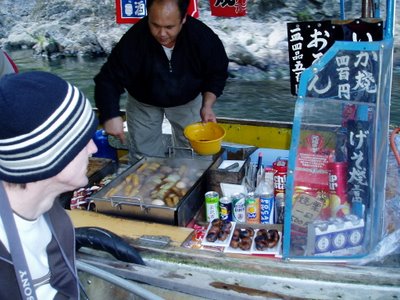Susan Cheever, in her wonderful biography of her father John Cheever entitled Home Before Dark, writes about a contest she and her father used to have thinking of potential book titles. One they both liked was 'Home Before Dark' and it became the title of her book. I have always loved the title, and the sentiment: although I don't mind working late during Daylight Savings Time, in the late fall and winter I crave flannel and homey food. It's fall here, and we are in the mountains when at Kameoka, and the leaves are turning, making it feel just a little like home. And I have a long walk from the train station (where I take the bus to and from the school) so I have to leave not long after four if I really want to be Home Before Dark.
It will take me a while to catch up with describing the transition from China to Japan, although I may just jump right into Japan without talking too much more about China. Japan is SO different! Here's just one example: readers of this blog will know how much I discuss food - and of course the food here is quite different (rarely spicy, different in texture, presentation, and cooking methods), which we knew. But our experience is made even more distinct because we are cooking for ourselves now and living relatively far away from one another, in apartments spread out along the JR train line near Kyoto, some in Nishioji, some near Kyoto Station, some in Hanazono. I am in a house in Kameoka owned by a professor and his wife who live next door. Last night, anxious to see some human beings after five p.m., I invited the students to dinner and cooked for them. I made spaghetti with Bolognese sauce (a Marcella Hazan More Northern Italian Cooking recipe I know by heart), chicken soup with Chinese noodles, salad with a vinagrette, and garlic bread. It was fun to cook for an enthusiastic group of eaters, including seven guys who are hard to fill up. I have just two burners, so there was a lot of dumping pasta into a collander and refilling it for a new round of spaghetti. Everyone helped out - Natalia chopped the vegetables, Aaron made slice after slice of garlic bread with butter and chopped garlic, Parker and Ashley washed dishes, Valeria (at KGU for the term on an exchange) brought mochi mochi - sweet rice balls with a sweet teriyaki sauce; Natalia brought delicious pastries from a French-style bakery near Kyoto Station, Aaron brought soft drinks, Erik brought little ice cream bars, and Jim and Jeff brought cookies. To serve 12 people on a budget I made the sauce from scratch and used the leftover onion, carrots, and celery left over from the Bolognese, along with some chicken necks (the only chicken I could find with bones at the grocery store) to make the chicken soup, made the vinagrette from olive oil supplied by my landlords and a small bottle of balsamic vinegar I splurged on, and garlic bread from large, thick slices of white bread (reminscent of Texas toast). The bread comes only five or six slices to a package, so we went through quite a lot. I was happy to find canned Italian tomatoes, celery (158 yen for ONE large stalk - not bunch, stalk), beautiful carrots, and onions. There was even a container of oregano and basil at the house which went into the chicken soup. I found the small, knotted Chinese noodles in the foodstore that Jackie likes and added them to the soup.
No English language television for us (we enjoyed CNN from Hong Kong and a huge array of cable stations in China, including HBO from Singapore and English-language programming on a number of other stations). Oddly enough, although I am watching an awful lot of Japanese infomercials, there was coverage of a DuPage County congressional race, the one between Pete Roskam and Tammy Duckworth. Although the program was in Japanese, it was fairly extensive, featuring charts of the Senate and House seats and even maps of blue and red states! It felt like a little touch of home to see an Illinois race and hear Illinois voices!

 Yesterday several of us took a river tour from Kameoka. The top photo is of the autumn leaves turning red, which is a really big deal in Japan, drawing Japanese tourists and locals. The lower photo is actually from almost the end of the tour, when a snack boat came by selling grilled squid, tofu, eggs, and daikon. You can see Tim, who was smart enough to bring a hat. It was a little chilly on the river, but beautiful.
Yesterday several of us took a river tour from Kameoka. The top photo is of the autumn leaves turning red, which is a really big deal in Japan, drawing Japanese tourists and locals. The lower photo is actually from almost the end of the tour, when a snack boat came by selling grilled squid, tofu, eggs, and daikon. You can see Tim, who was smart enough to bring a hat. It was a little chilly on the river, but beautiful.



